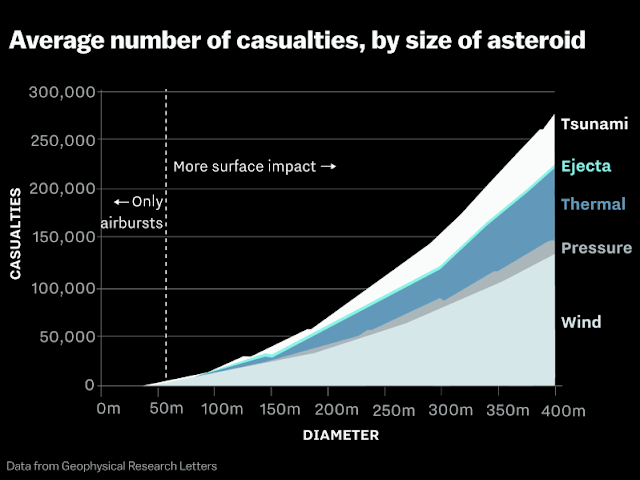The chances of dying via an asteroid impact are very, very small.
Asteroids that pose an existential threat to life on Earth only strike once every 500,000 years or more. Even the 140-meter-wide asteroids that could destroy cities and regions rain down death once every 10,000 years. And the risk of being even injured from a 20-meter object — like the one that exploded over Chelyabinsk, Russia, in 2013 and hurt nearly 1,500 people — is tiny.
But, okay: WHAT IF? If a huge asteroid were to smash into Earth, what would happen to us? We all know Hollywood’s take: Either we’ll be engulfed by a huge fireball or swallowed by a massive tsunami.
The journal Geophysical Research Letters in 2017 published an analysis of the likely source of casualties from an asteroid impact. In it, the scientists ran a computer model where they simulated the impact of 50,000 asteroids — from the very tiny to 400-meter monsters — all over the globe. They estimated how each of the asteroids would create chaos (i.e., if they hit in water, they’d perhaps create a tsunami, if they hit land, they would generate debris and a shockwave), and estimated the causalities of each of the impacts based on the population density in the area.
In sum, here’s what they found: If you’re going to die via an asteroid, it will be the wind and shockwave that gets you.
Surprisingly "effects such as cratering, seismic shaking and ejecta deposition [i.e., ejected debris] provide only a minor contribution to overall loss," the study concluded.
Why wind? It’s because if a large-enough asteroid explodes in the air before hitting the Earth (and generating tsunamis, craters, and fire-filled torrents of death), the resulting shockwave could blast winds powerful enough to flatten cities. The pressure from the blast could rupture internal organs. Bottom line: An asteroid doesn’t have to reach the ground intact to cause chaos. In their analysis, 60 percent of all asteroid deaths were caused by wind and pressure.
The chart above shows that as the asteroids get larger, your chances of dying of anything other than wind increase, but the wind would still the No. 1 cause of death.
Tsunami’s aren’t as much of a factor, relatively speaking, because in many areas, the geography of the shoreline would dampen their destructive reach, New Scientist explains in its report on the study. Also: Wind is a factor in every asteroid collision, and tsunamis are only implicated in impacts over water.
So, should this graphic keep you up at night? No.
Talking about the risk of asteroid impact is tricky. We’re not likely to see a huge destructive asteroid in our lifetimes. Those threaten future generations. “You have to think about the risk in terms of it’s not a risk to a person or a city, but a risk to humanity,” said Eric Christensen, who hunts asteroids for NASA at the Catalina Sky Survey.
Small asteroid strikes are much more likely. But for one to land near you would be an incredible stroke of bad luck.
“One of the most remarkable things about the Chelyabinsk impactor for me was that it happened over a populated area,” Christensen says. “Ninety-eight percent of the planet is unpopulated or very sparsely populated.”
And that’s why NASA’s tracking these baddies now. The more we keep an eye on them, the more we can devise engineering solutions to push a deadly asteroid off a collision course. The Center for Near Earth Object Studies at the NASA Jet Propulsion Laboratory has logged around 16,000 asteroids that come close to Earth’s orbital neighborhood. And there are thousands more to find.





